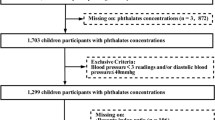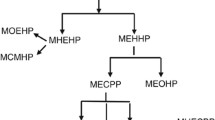Abstract
This study aims to investigate the association of urinary concentration of phthalate metabolites with body mass index (BMI) and waist circumference (WC) in 2016 on 242 children and adolescents, aged 6–18 years living in Isfahan, Iran. Urinary concentration of mono-butyl phthalate (MBP), mono-benzyl phthalate (MBzP), mono-2-ethylhexyl phthalate (MEHP), mono-methyl phthalate (MMP), mono (2-ethyl-5-exohexyl) phthalate (MEOHP), and mono (2-ethyl-5hydroxyhexyl) phthalate (MEHHP) metabolites were determined. For comparison of means, t test and to evaluate the association of analytes in different groups according to weight ANOVA was used. The correlation was applied to determine the association between phthalate metabolites with age, sex, WC, BMI, and BMI z-score. The univariate and multivariate regression models were used to determine the association of metabolites concentration with BMI z-score and WC. Mean (SD) BMI, BMI z-score and WC were 23.89 (4.41) kg/m2, 1.37 (1.3), and 82.37 (12.71) cm, respectively. There was a significant correlation between boys’ age with BMI z-score (p value = 0.03) and WC (p value = 0.01), while the corresponding figures were not statistically significant in girls (p value = 0.48, and 0.4, respectively). Of the total population, 37 participants (15.3%) were obese. MMP, MBP, and MBzP metabolites were observed in all samples while MEHP, MEOHP, and MEHHP in 99.6, 95.86, and 96.28% of the studied population. Mean concentration of MMP (64.38 μg/L) and MBzP (268 μg/L) had the lowest and highest concentrations of metabolites, respectively. A significant relationship was observed among all studied metabolites and weight groups (p value ≤ 0.02). After adjustment for potential confounders, all metabolites (except MMP) showed a low-to-moderate positive and significant relationship with BMI z-score (β = 0.17–0.3). A weak to moderate positive and significant relationship was observed between all phthalate metabolites and WC (β = 0.14–0.39). The concentration of phthalate metabolites was much higher in the population living in Isfahan-Iran than in some other populations, indicating a high exposure to contaminants. Therefore, further studies and preventive measures are required for improving the environmental health.
Similar content being viewed by others
References
Becker K, Seiwert M, Angerer J, Heger W, Koch HM, Nagorka R, Roßkamp E, Schlüter C, Seifert B, Ullrich D (2004) DEHP metabolites in urine of children and DEHP in house dust. Int J Hyg Environ Health 207(5):409–417. https://doi.org/10.1078/1438-4639-00309
Becker K, Güen T, Seiwert M, Conrad A, Pick-Fuß H, Müller J, Wittassek M, Schulz C, Kolossa-Gehring M (2009) GerES IV: phthalate metabolites and bisphenol A in urine of German children. Int J Hyg Environ Health 212(6):685–692. https://doi.org/10.1016/j.ijheh.2009.08.002
Boas M, Feldt-Rasmussen U, Skakkebæk NE, Main KM (2006) Environmental chemicals and thyroid function. Eur J Endocrinol 154(5):599–611. https://doi.org/10.1530/eje.1.02128
Buser MC, Murray HE, Scinicariello F (2014) Age and sex differences in childhood and adulthood obesity association with phthalates: analyses of NHANES 2007–2010. Int J Hyg Environ Health 217(6):687–694. https://doi.org/10.1016/j.ijheh.2014.02.005
CDC (Centers for Disease Control and Prevention) (2003) Second national report on human exposure to environmental chemicals. CDC, Atlanta
(2012) The Fourth National Report on Human Exposure to Environmental Chemicals, Updated Tables, February 2012. Centers for Disease Control and Prevention; National Center for Environmental Health; Division of Laboratory Sciences; Atlanta, GA
Chen M, Tao L, Collins EM, Austin C, Lu C (2012) Simultaneous determination of multiple phthalate metabolites and bisphenol-A in human urine by liquid chromatography–tandem mass spectrometry. J Chromatogr B 904:73–80. https://doi.org/10.1016/j.jchromb.2012.07.022
Damstra T, Barlow S, Bergman A, Kavlock R, Van Der Kraak G (2002) Global assessment of the state-of-the-science of endocrine disruptors. World Health Organization, Geneva
Deierlein AL, Wolff MS, Pajak A, Pinney SM, Windham GC, Galvez MP, Silva MJ, Calafat AM, Kushi LH, Biro FM, Teitelbaum SL, Breast Cancer and Environment Research Program (2016) Longitudinal associations of phthalate exposures during childhood and body size measurements in young girls. Epidemiology 27(4):492–499. https://doi.org/10.1097/EDE.0000000000000489
Diamanti-Kandarakis E, Bourguignon J-P, Giudice LC, Hauser R, Prins GS, Soto AM, Zoeller RT, Gore AC (2009) Endocrine-disrupting chemicals: an Endocrine Society scientific statement. Endocr Rev 30(4):293–342. https://doi.org/10.1210/er.2009-0002
Gore AC, Chappell V, Fenton S, Flaws JA, Nadal A, Prins GS et al (2015) EDC-2: the endocrine society’s second scientific statement on endocrine-disrupting chemicals. Endocr Rev 36(6):1–150. https://doi.org/10.1210/er.2015-1010
Gray Jr LE, Ostby J, Furr J, Price M, Veeramachaneni DR, Parks L (2000) Perinatal exposure to the phthalates DEHP, BBP, and DINP, but not DEP, DMP, or DOTP, alters sexual differentiation of the male rat. Toxicol Sci 58(2):350–365. https://doi.org/10.1093/toxsci/58.2.350
Hatch EE, Nelson JW, Qureshi MM, Weinberg J, Moore LL, Singer M et al (2008) Association of urinary phthalate metabolite concentrations with body mass index and waist circumference: a cross-sectional study of NHANES data, 1999–2002. Environ Health 7:27. https://doi.org/10.1186/1476-069X-7-27
Hauser R, Calafat A (2005) Phthalates and human health. Occup Environ Med 62(11):806–818. https://doi.org/10.1136/oem.2004.017590
Hauser R, Duty S, Godfrey-Bailey L, Calafat AM (2004) Medications as a source of human exposure to phthalates. Environ Health Perspect 112(6):751–753. https://doi.org/10.1289/ehp.6804
Kelishadi R, Majdzadeh R, Motlagh ME, Heshmat R, Aminaee T, Ardalan G, Esmaillzadeh A, Azadbakht L, Poursafa P, Movahedian M (2012) Development and evaluation of a questionnaire for assessment of determinants of weight disorders among children and adolescents: the Caspian-IV study. Int J Prev Med 3:699
Khalil N, Chen A, Lee M (2014) Endocrine disruptive compounds and cardio-metabolic risk factors in children. Curr Opin Pharmacol 19:120–124. https://doi.org/10.1016/j.coph.2014.09.015
Kuczmarski RJ, Ogden CL, Guo SS, Grummer-Strawn LM, Flegal KM, Mei Z et al (2000) CDC growth charts for the United States: methods and development. Vital Health Stat 11 2002(246):1–190
Lewis RC, Meeker JD, Peterson KE, Lee JM, Pace GG, Cantoral A, Téllez-Rojo MM (2013) Predictors of urinary bisphenol A and phthalate metabolite concentrations in Mexican children. Chemosphere 93(10):2390–2398. https://doi.org/10.1016/j.chemosphere.2013.08.038
Maresca MM, Hoepner LA, Hassoun A, Oberfield SE, Mooney SJ, Calafat AM, Ramirez J, Freyer G, Perera FP, Whyatt RM, Rundle AG (2016) Prenatal exposure to phthalates and childhood body size in an urban cohort. Environ Health Perspect 124(4):514–520. https://doi.org/10.1289/ehp.1408750
Owen C, Nightingale C, Rudnicka A, Sattar N, Cook D, Ekelund U et al (2010) Physical activity, obesity and cardiometabolic risk factors in 9-to 10-year-old UK children of white European, South Asian and black African-Caribbean origin: the Child Heart and health Study in England (CHASE). Diabetologia 53(8):1620–1630. https://doi.org/10.1007/s00125-010-1781-1
Parastar S, Ebrahimpour K, Hashemi M, Maracy MR, Ebrahimi A, Poursafa P et al (2017) Association of urinary concentrations of four chlorophenol pesticides with cardiometabolic risk factors and obesity in children and adolescents. Environ Sci Pollut Res:1–8
Perng W, Watkins DJ, Cantoral A, Mercado-García A, Meeker JD, Téllez-Rojo MM, Peterson KE (2017) Exposure to phthalates is associated with lipid profile in peripubertal Mexican youth. Environ Res 154:311–317. https://doi.org/10.1016/j.envres.2017.01.033
Philips EM, Jaddoe VW, Trasande L (2017) Effects of early exposure to phthalates and bisphenols on cardiometabolic outcomes in pregnancy and childhood. Reprod Toxicol 68:105–118. https://doi.org/10.1016/j.reprotox.2016.08.015
Sarath Josh M, Pradeep S, Vijayalekshmi Amma K, Balachandran S, Abdul Jaleel U, Doble M et al (2014) Phthalates efficiently bind to human peroxisome proliferator-activated receptor and retinoid X receptor α, β, γ subtypes: an in silico approach. J Appl Toxicol 34(7):754–765. https://doi.org/10.1002/jat.2902
Saravanabhavan G, Guay M, Langlois É, Giroux S, Murray J, Haines D (2013) Biomonitoring of phthalate metabolites in the Canadian population through the Canadian Health Measures Survey (2007–2009). Int J Hyg Environ Health 216(6):652–661. https://doi.org/10.1016/j.ijheh.2012.12.009
Shang X, Li Y, Liu A, Zhang Q, Hu X, Du S et al (2012) Dietary pattern and its association with the prevalence of obesity and related cardiometabolic risk factors among Chinese children. PLoS One 7(8):43183. https://doi.org/10.1371/journal.pone.0043183
Svensson K, Hernández-Ramírez RU, Burguete-García A, Cebrián ME, Calafat AM, Needham LL, Claudio L, López-Carrillo L (2011) Phthalate exposure associated with self-reported diabetes among Mexican women. Environ Res 111(6):792–796. https://doi.org/10.1016/j.envres.2011.05.015
Trasande L, Sathyanarayana S, Messito MJ, Gross RS, Attina TM, Mendelsohn AL (2013) Phthalates and the diets of US children and adolescents. Environ Res 126:84–90. https://doi.org/10.1016/j.envres.2013.07.007
Wang H, Zhou Y, Tang C, He Y, Wu J, Chen Y et al (2013) Urinary phthalate metabolites are associated with body mass index and waist circumference in Chinese school children. PloS One 8:e56800. https://doi.org/10.1371/journal.pone.0056800
Yang TC, Peterson KE, Meeker JD, Sánchez BN, Zhang Z, Cantoral A, Solano M, Tellez-Rojo MM (2017) Bisphenol A and phthalates in utero and in childhood: association with child BMI z-score and adiposity. Environ Res 156:326–333. https://doi.org/10.1016/j.envres.2017.03.038
Acknowledgements
The authors wish to thank Vice Chancellor of Research of Isfahan University of Medical Sciences (IUMS), Iran for the financial support.
Author information
Authors and Affiliations
Corresponding author
Ethics declarations
Competing interests
The authors declare that they have no competing interests.
Additional information
Responsible editor: Philippe Garrigues
Rights and permissions
About this article
Cite this article
Amin, M.M., Parastar, S., Ebrahimpour, K. et al. Association of urinary phthalate metabolites concentrations with body mass index and waist circumference. Environ Sci Pollut Res 25, 11143–11151 (2018). https://doi.org/10.1007/s11356-018-1413-8
Received:
Accepted:
Published:
Issue Date:
DOI: https://doi.org/10.1007/s11356-018-1413-8




